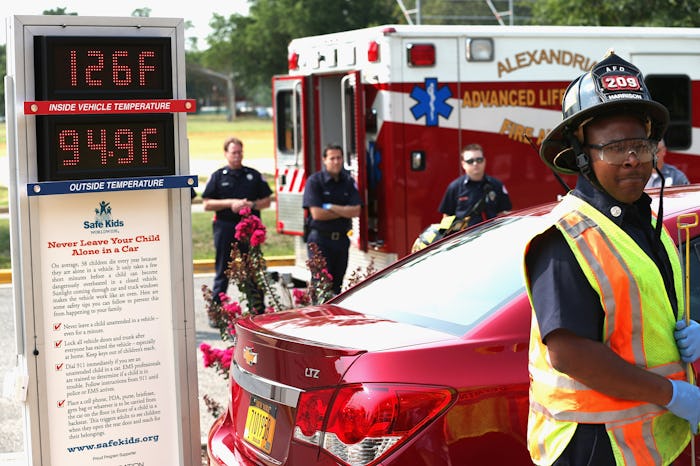Life

The Number Of Kids Killed In Hot Cars Has Risen In 2016 & It Is Beyond Heartbreaking
For me, part of becoming a mom has included having a running narrative of all the absolutely awful, horrifying things that could possibly happen to my children at any moment. And one of the things at the top of that list is having them die after being left in a hot car. It seems that we hear of these almost-incomprehensible stories every summer, always followed by debates and commentary about how it happened and what can be done to prevent it. But recent figures show the number of kids killed in hot cars has risen in 2016, despite these conversations, and the statistics are nothing less than completely heartbreaking.
According to a report by NBC New York Monday, 28 children this year have died as a result of being left in hot cars. That figure in itself is beyond tragic, but what's worse is that more children this year have died in hot cars than last year, suggesting that the problem is getting worse, not better, despite awareness campaigns and education efforts. According to an ongoing report by Jan Null from San Jose State University's Department of Meterology & Climate Science, the number of deaths in 2016 is up from 24 children in 2015, and is not far off from the 31 deaths in 2014 (Null's research actually puts the 2016 total at 29, not 28).
The worst year for vehicular heatstroke deaths? 2010, when 49 children died in hot cars — much higher even than the 38 yearly deaths that has been the average since 1998 (which, is essentially one death every nine days, according to KidsAndCars.org). According to Null's findings, the majority of vehicular heatstroke deaths have occurred in children under the age of 2, with 32 percent of all deaths since 1998 (208 cases) involving children younger than 1 year.
So why is it that children are continuing to die in accidents that should be largely preventable? There are many factors. According to KidsAndCars.org, one of the primary reasons is that cars heat up incredibly quickly, with the majority of the increase in temperature (80 percent) happening during the first 10 minutes. What's more is that the outside temperature is not a reliable gauge for what the inside of the car will feel like: The temperature inside a car can reach as high as 125 degrees in a few short minutes, and children have died of heatstroke in cars when the outside temperature was as low as 60 degrees. Think you can just crack a window and be OK? Not so, says KidsAndCars.org: Daving the windows open slightly does not help decrease the temperature, or slow the heating process.
Another factor that contributes to these deaths is that children are much more susceptible to heatstroke than adults. According to the outlet, "a child's body overheats 3-5 times faster than an adult's body," and when you also consider that infants and young children also often fall asleep during car rides — rendering them pretty much silent and easier to a tired/stressed/zoned-out caregiver to accidentally forget about — it's a perfect storm of circumstances.
Further compounding the problem is that most parents assume they could never forget their kids in the car, that these kinds of accidents only happen to other people, or to those less devoted to their children. But the research has found that's also not true: in the majority of cases of vehicular heatstroke deaths, well-meaning parents just lost awareness of their surroundings, were functioning on "auto-pilot," and made the devastating mistake of forgetting to double-check their backseat before leaving their cars.
Even if many of these cases are accidental, there are still lots of safety measures that parents can put in place to reduce to likelihood it will happen to them. Perhaps most importantly, all parents need to understand that there is no "safe" length of time to leave a child unattended in a car for any reason (or pets, for that matter). Beyond that, the National Safety Council advises that anyone driving with a child should get in the habit of leaving something important (purse, wallet, cell phone, or even one of their shoes) in the backseat of their car, so that they'll have an added reminder to check the car before getting out. A stuffed animal, or something else belonging to your child, left on the front seat can be helpful as a reminder that they are in the car — and that same stuffed animal can be left in the child's seat when it is empty, so that the moving of it back and forth can also be another built-in reminder. Most importantly, KidsAndCars.org founder Jeanette Fennell told CNN, is that anyone who ever drives with children should get in the habit of always checking their backseat before leaving their car, no matter what:
The biggest mistake people make is thinking that it can't happen to them. Everyone should practice those safety measures and do whatever they have to do to remind themselves to check the backseat.
This advice can sometimes feel like it should be obvious, and in some ways, it is obvious. But the fact that, year after year, kids are continuing to die shows that the problem is not that caregivers don't realize that hot cars are dangerous, it's that they made the same kind of tragic mistake that any one of us could make at any point, and just didn't think to double-check. But getting in the habit of making backseat checks an automatic part of your drive? That could literally save your child's life, and definitely should not be overlooked.